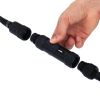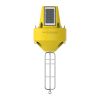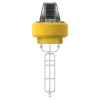NexSens TS210 Thermistor String
Features
- Integrated thermistor with standard or custom spacing
- +/- 0.075 C accuracy for precision temperature measurements
- Marine-grade cable with braided Kevlar core
- Expedited repair and warranty service
- Lifetime technical support
- More
The NexSens TS210 Thermistor String provides high accuracy temperature data for profiling in lakes, streams, and coastal waters. It features an integral titanium thermistor secured and epoxied in a protective housing for underwater deployments. A marine-grade cable with braided Kevlar core help ensure reliability in extreme environments.
Each sensor is accurate to +/-0.075 C for high-precision measurements. The exposed titanium thermistor makes direct contact with water, allowing readings to stabilize within 60 seconds. Temperature data is transmitted on a RS-485 Modbus RTU string bus for integration with data loggers and SCADA systems. The string is powered by 4-28 VDC for operation on a 12 or 24 VDC power supply.
TS210 strings are available standard with 1m spacing or at custom intervals to meet project requirements. Cable lengths are available up to 1,219 meters (4,000 feet) with a maximum 250 nodes. Strings terminate in a NexSens UW plug and receptacle connector, allowing additional sections or sensors to be added as required. Optional accessories include a bottom pressure sensor, cable clamps, stainless steel mooring line, and communication adapters.
- Sensor: Thermistor
- Range: 0 to 45 C (32 to 113 F)
- Accuracy: +/-0.075 C
- Resolution: 0.01 C
- T90 Response Time: 60 seconds
- Refresh Rate: 2 seconds
- Maximum Sensors: 250
- Maximum Length: 1219m (4000 ft.)
- Maximum Depth: 200m (656 ft.)
- Communications: RS-485 Modbus RTU
- Power Requirement: 4-28 VDC
- Current Draw Per Node: 1.65mA active; 1.45mA idle; 0.04mA sleep
- Connector: 8 pin, sensorBUS
- Dimensions: 7.62cm L x 3.56cm Dia. (3.0" L x 1.4" Dia.)
In The News
Great Lakes Research Center: Designing Targeted Monitoring Solutions
According to the National Oceanic and Atmospheric Administration ( NOAA ), the Great Lakes have more miles of coastline than the contiguous Atlantic and Pacific coasts combined and contain 20 percent of the world's freshwater, making it a critical region to protect and conserve. Continuous monitoring and data-informed resource management are key components of managing waters in the region. Hayden Henderson, a research engineer with the Great Lakes Research Center (GLRC), designs and deploys monitoring platforms throughout the Great Lakes. With a background in environmental engineering, Henderson enjoyed the challenge of creating systems and making them work to obtain difficult, remote measurements.
Read MoreClimate Change and Microplastics: Monitoring Lake Champlain
Most people go to Lake Champlain for its exceptional views and thrilling boating, but it’s also home to a wide variety of interesting aquatic research projects. From studying microplastics to thermal dynamics of the lake, Timothy Mihuc, director of the Lake Champlain Research Institute (LCRI) at the State University of New York at Plattsburgh (SUNY Plattsburgh), has spent his career studying aquatic ecosystems. As an aquatic biologist, he’s the main investigator on Lake Champlain’s research studies while also managing their grants, employees, and their hands-on buoy work. Over the years, LCRI has received a number of environmental grants that aid in its monitoring research.
Read MoreThin Ice: Monitoring Winter Lake Dynamics at Mohonk Lake
Historically, water quality monitoring during the winter has been difficult and often avoided altogether—however, monitoring throughout the year can highlight the influence of various environmental stressors and track the changes systems undergo during the winter. In particular, long-term monitoring efforts in systems like Mohonk Lake can underline the effects of climate change and acid rain. David Richardson, a professor of biology at the State University of New York (SUNY) at New Paltz , spends his time outside of the classroom monitoring the nearby watersheds. After getting his engineering undergraduate degree, Richardson realized he wasn't interested in the typical job offerings and applied to an ecological science graduate program at the University of Maryland.
Read More




































